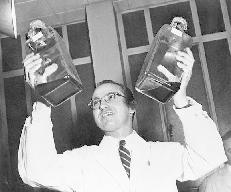


 When Dr. Jonas Salk envisioned the idea of the Salk Institute for Biological Studies, it was with the idea of creating a vibrant, intellectual community, dedicated to pursuing the kinds of scientific achievements that had made him an international figure only five years before.
When Dr. Jonas Salk envisioned the idea of the Salk Institute for Biological Studies, it was with the idea of creating a vibrant, intellectual community, dedicated to pursuing the kinds of scientific achievements that had made him an international figure only five years before.Thus a monument to the conquest of polio faithful to the facts would consist of not one man in a white lab coat but two of them glaring at each other. Both Drs. Jonas Salk and Albert Sabin could and did make convincing cases for themselves and pretty good ones against each other too. But since the public usually prefers one hero to two, and since Salk did get there first, he got the monument.
Jonas Salk was born in New York to proud Russian and Jewish immigrant parents. Though the family was materially poor and lacked formal education, they urged their children to work and study hard. Jonas Salk was the first sibling to enter the City College of New York to study Law, but fate intervened and he entered medical school instead of getting a law degree at the New York University.
Scientists, microbiologists worked hard to find an antidote, and finally their efforts and hard work paid off. On April 12, 1955 an official announcement was made that Dr. Jonas Salk has finally developed a vaccine that will once and for all eradicate polio. Dr. Jonas Salk became an overnight sensation not only in the United States but worldwide.
But who is Dr. Jonas Salk?
Jonas Salk, while still in medical school, was invited to do some research on the recently discovered influenza virus. Eager to learn, Salk succeeded in his research by depriving the virus the ability to infect and in so doing giving immunity to the illness as well. Thus in 1938, together with microbiologist Thomas Francis Jr., Salk developed the first vaccine on influenza and was used extensively by the Armed Forces in World War II. This became the foundation of his research on polio later on.
After completing medical school and his internship, he went back to the study of influenza, the flu virus. In 1947, Jonas Salk accepted residency at the Medical School of the University of Pittsburgh and worked with the National Foundation for Infantile Paralysis. It was here that he devoted 8 years of his life working to develop the polio vaccine. In 1952 his vaccine was developed; he and his family including his staff and volunteers were first inoculated to test its effectiveness.
The vaccine proved successful as everybody who received the test vaccine started producing anti-bodies against the virus so that nobody else became inflicted with polio and no side effect was observed. Jonas Salk published the results in the Journal of the American Medical Association the following year and a nationwide testing was made. It was during this time that worst polio outbreak happened involving 57,628 cases. It was Salk's former mentor Thomas Francis Jr. that helped and directed the mass vaccination of schoolchildren.
The success of the vaccination put Jonas Salk's fame forward and endeared himself to the public when he refused to patent the vaccine and the accompanying financial remuneration. Dr. Jonas Salk in his statement "merely wished to see the vaccine disseminated as widely as possible". The March of Dimes, a non-government organization hoping to boost publicity and raise donation to fund the vaccination programs praised the achievements of Salk to the point of offending his colleagues.
In 1963 he founded the Jonas Salk Institute for Biological Studies, a center devoted solely for medical and scientific research. His last years were devoted to finding a vaccine against AIDS. Dr. Jonas Salk died on June 23, 1995. He was 80 years old.
Jonas Salk liked to go down to the racetrack on occasion and place a wager or two on the ponies. But, he didn't stop there. According to unconfirmed reports, Jonas Salk like to sneak back into the stables behind the racetrack and actually spank the horses on their behinds. No one knows why he like to do this, but on more than one occasion he was spotted coming back into the stands with a horseshoe imprint upon his forehead.